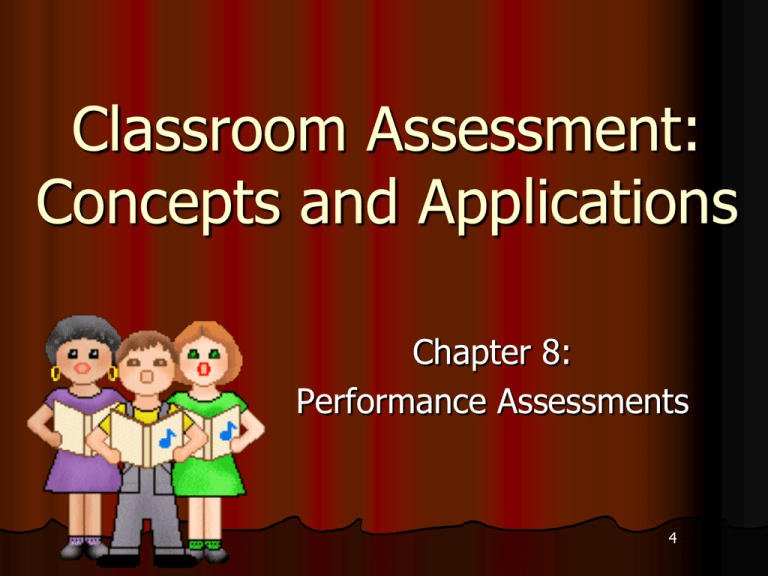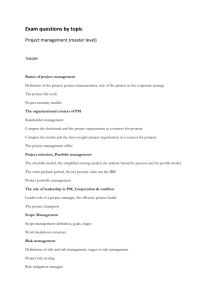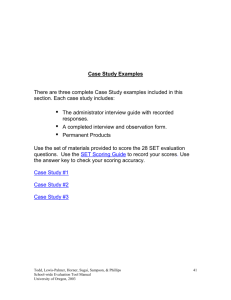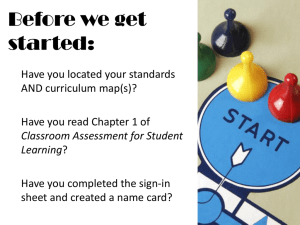
Classroom Assessment:
Concepts and Applications
Chapter 8:
Performance Assessments
4
Performance Assessment
Notebook:
Tab 5: Examples, page PA3
Require students to demonstrate skill
and knowledge by producing a formal
product or performance.
Demonstration includes multiple
objectives simultaneously.
An alternative to timed tests (multiplechoice and short answer).
Generally require work over an
extended period of time
Turn to Page 202:
Examples of Four Assessment Approaches
Selection
Supply
Multiple-choice
Completion
True-false
Label
Matching
a diagram
Short-answer
Concept map
Product
Essay,
story, or
poem
Research paper
Writing portfolio
Diary or journal
Science fair
project
Art exhibit or
portfolio
Performance
Musical,
dance, or
dramatic performance
Science lab
demonstration
Typing test
Athletic competition
Debate
Oral presentation
Cooperation in groups
Things you
see or listen to
Things you
can hold
Short answer test items: Essays and other
extended-response
items:
CAN give insight into
Provide a product as
student thinking.
evidence
of
student
However, the teacher
thinking
observes the result
Permits the teacher to
of the student’s
see the logic of
thinking but not the
arguments, the
process!
organization of the
response, and their
conclusions.
Turn to Page 204:
Comparison of Various Types of Assessments
Objective Test
Essay Test
Oral Question
Assessment
Performance
Purpose
Sample knowledge
with maximum
efficiency and
reliability
Assess thinking
skills and/or
mastery of how a
body of knowledge
is structured
Assess knowledge
during instruction
Assess ability to
translate
knowledge and
understanding into
action
Student’s
Response
Read, evaluate,
select
Organize, compose
Oral answer
Plan, construct and
deliver an original
response
Major
Advantage
Efficiency—can
administer many
items per unit of
testing time
Can measure
complex cognitive
outcomes
Joins assessment
and instruction
Provides rich
evidence of
performance skills
Influence on
Learning
Overemphasis on
recall encourages
memorization; can
encourage thinking
skills if properly
constructed
Encourages
thinking and
development of
writing skills
Stimulates
participation in
instruction,
provides teacher
immediate
feedback on
effectiveness of
teaching
Emphasizes use of
available skill and
knowledge in
relevant problem
contexts
3 Reasons for Popularity
of Performance Assessment
Increased inclusion in formal, statewide assessment
programs
Increased classroom emphasis on problem-solving,
higher-level thinking, and real-world reasoning skills
Provides alternative testing formats for a variety of
student learning styles
Performance-Oriented Subjects
Reading, writing, and speaking are the most
common areas of performance assessment.
Other subjects, such as physical education,
science, and math may also use hands-on
demonstrations to assess student learning.
Developing Balanced Assessments
It is important for
teachers to balance
supply and selection
assessments
with
performance and product
assessments.
15
1/2
Early Childhood Students
Assessment at this age focuses on the
following:
Gross and fine motor development
Verbal and auditory acuity
Visual development
Social behaviors
Special Needs Students
Students
with severe disabilities
are given performance tasks that
focus on self-help skills.
These
tasks support the
development of cognitive, affective,
and psychomotor abilities.
© 2008 McGraw-Hill Higher Education. All rights reserved.
18
Developing
Performance Assessments
Fold a sheet of paper into four sections.
Number each section, 1 to 4.
19
Developing
Performance Assessments
A diving competition is an
Instructional example of a
skill assessed by a
performance assessment.
1. Have a clear purpose.
2. Identify observable
aspects of the
performance/product.
3. Provide an appropriate
setting for judging the
performance/product.
4. Provide a judgment or
score.
20
1. Purpose
Is our purpose to…
Grade students
Develop portfolios of student
work
Diagnosis student learning
Provide concrete examples of
student work for parent
conferences
Develop the performance assessment to
meet your pre-defined purpose.
21
Assessment Goals
If the goal of
assessment is
formative, the focus
of the scoring criteria
will be on giving
feedback to students
about their overall
strengths and
weaknesses
If the goal of
assessment is
summative, the focus
of the scoring criteria
will be on rating the
quality of the
student’s product or
performance
22
2. Identify Performance Criteria
Performance criteria are the specific
aspects a student should perform to
properly carry out a performance or
create a product.
These are the heart of performance
assessment but tend to be the most
problematic.
23
Examples of Performance Criteria
© 2008 McGraw-Hill Higher Education. All rights reserved.
24
Guidelines in Developing
Performance Criteria
1. State criteria that are meaningful,
important, and easily understood.
2. Develop essential criteria; 6 to 12
is manageable
3. Revise and clarify initial
criteria based on experience and
feedback.
© 2008 McGraw-Hill Higher Education. All rights reserved.
25
Example of Performance Criteria
Are they:
Important?
Easily understood?
Are there 6 to 12
criteria?
For writing a well-organized paragraph:
Indents first sentence.
Topic sentence sets main idea of paragraph.
Following sentences support the main idea.
Sentences are arranged in logical order.
Uses age-appropriate vocabulary.
Writes in complete sentences.
Capitalizes proper nouns and first words in
sentences.
Makes no more than three spelling errors.
Conclusion follows logically from prior
sentences.
Handwriting is legible.
Develop
Observable Performance
1. Try the performance yourself.
2. List the important aspects.
3. Limit the number of criteria.
4. Work with a team of teachers to develop
performance criteria.
5. Use language that specifies observable
student behavior or product characteristics.
6. Do not use ambiguous words.
7. Arrange the criteria in the order they are
likely to be performed.
8. Check for existing performance criteria.
27
3. Provide a
Conducive Setting
Teachers may observe
behaviors as they naturally
occur in the classroom or in a
more formal exercise.
Formally structured
assessments are needed
when dealing with lowfrequency behaviors and
when making important
decisions.
28
4. Provide a Score
Holistic
scoring provides a single,
overall score for a performance or
product.
Group placement
Grades
Analytic
scoring provides a separate
score for each individual criterion.
Diagnose student weaknesses/strengths
29
4. Provide a Score
Develop a Scoring System
Many options are available for collecting, recording,
and summarizing observations of student
performance:
a. Anecdotal records
b. Checklists
c. Rating scales
d. Rubrics
e. Portfolios
30
1/2
a. Anecdotal Records
Anecdotal records are detailed written accounts of
significant, individual student events and behaviors
the teacher has observed.
STUDENT
OBSERVER
Lynn Gregory
J. Ricketts
DATE 9/22/2007
Lynn entered the room in an orderly manner and moved directly for her
desk. She began preparing for class by taking out her homework and a
pencil. Lynn then became interested in a conversation that was occurring
between two students beside her. She left her desk and became engaged in
the conversation. She quickly became animated and, when the bell rang, had
difficulty
settling back
For several
minutes, she
repeatedly
shifted her
•Description
ofdown.
student’s
strengths
and
weaknesses
focus
from the
to the students
beside her, at times whispering to
based
onteacher
pre-specified
criteria
them. Only after being spoken to by the teacher was Lynn able to fully focus
•Judgment and recommendations are absent
on the lesson at hand.
1/3
b. Checklists
Notebook: Tab 5:
Page 41+; Example, page C 1.
A checklist is a written list of performance criteria.
(See example on page 218)
As a student’s performance is observed or product
judged, the scorer determines whether it meets
each criterion and “checks” it on the list.
2/3
Checklists: Advantages
They
are diagnostic, reusable, and
capable of charting student
progress.
They focus on specific
performances and show areas of
strength and weakness.
3/3
Checklists: Disadvantages
They give only two choices for each criterion:
performed or not performed. It provides no
gradation in scoring.
They make it difficult to summarize a student’s
performance into a single score.
Translate the number of criteria successfully completed
into a percentage.
Example: 9 correct out of 13 = 69%
Set up a standard for rating.
Example: A = 12 or 13 correct
B = 9 to 11 correct
C = 5 to 8
D = 4 or fewer
1/5
c. Rating Scales
Rating scales allow observers to judge
performance along a continuum rather than
as a dichotomy.
3 of the most common types:
Tab 3: page 43
Graphic
scales
Numeric scales
Descriptive scales (scoring rubrics)
2/5
2 Rules
Developing Rating Scales
1. Limit the number of rating categories to
3–5 well-defined and distinct rating scales.
(See page 221)
2. Use the same rating scale for each
performance criterion. This helps to focus
the rater’s attention and enhances scoring
reliability.
4/5
Rating Scales: Advantages
They
are diagnostic, reusable, and
capable of charting progress.
They measure the degree to which the
performance matches the criteria.
They focus on specific performances
and show areas of strength and
weakness.
5/5
Rating Scale: Disadvantages
They
They
are time consuming to construct.
make it difficult to summarize a
student’s performance into a single
score.
1/6
d. Rubrics
Notebook: Tab
5, page 45+;
page R4
A rubric is a set of
clear expectations
or criteria used to
help teachers and
students focus on
what is valued in
a subject, topic,
or activity.
They lay out criteria for different levels of performance, which are usually descriptive,
rarely numerical.
2/6
Scoring Rubrics
These
descriptive rating scales
require the rater to choose among
different descriptions of actual
performance.
To score, the teacher picks the
description that most closely
matches the student’s performance.
3/6
Rubrics: Two Scoring Methods
Holistic scoring (Tab 5, page 45) is used to
assess the overall performance of a student
across all the performance criteria. A holistic
rubric contains a single description.
Analytic scoring (Tab 5, page 48) is used to
assess individually each performance criterion
stated in the rubric.
4/6
Holistic Scoring
SUPERIOR
Can support opinion, hypothesize, discuss abstract topics,
And handle a linguistically unfamiliar situation.
ADVANCED
Can narrate and describe in past, present, and future
time/aspect, and handle a complicated
Situation or transaction.
INTERMEDIATE
Can create with language, ask and answer
simple questions on familiar topics,
and handle a simple situation
or transaction.
NOVICE
No functional ability;
speech limited to
memorized
material.
5/6
General Steps in Preparing
and Using Rubrics
6/6
Rubrics: Involving Students
Inform
students of the performance
criteria prior to the assessment.
Describe
and illustrate specific examples
of good and poor performance.
Practice
using rubrics with students.
1/8
e. Portfolios
A
portfolio is an extended
performance assessment that
includes multiple samples of student
products or performances.
Its
purpose is to show students’ work
and accomplishments over time.
2/8
3/8
Purposes of Portfolios
Show students’ typical work
Monitor progress and improvement over time
Help students engage in self-evaluation
Provide ongoing assessment of learning
Show connections among processes and products
Grading students
Facilitating teacher and parent meetings
4/8
Portfolios: Performance Criteria
Performance
criteria assess each of
the individual pieces within a portfolio.
They should align with a teacher’s
instructional objectives.
They allow students to help identify
performance criteria they are expected
to follow.
5/8
Portfolios: Setting
Portfolios require a safe,
accessible storage space.
Many portfolio pieces can be
gathered by the teacher in the
classroom.
Other pieces, such as oral speaking,
science experiments, and artistic
productions, require special
equipment or arrangements.
6/8
Portfolios: Scoring
First, decide the purpose of the portfolio.
Scoring portfolios is a time-consuming
process that involves judging each
individual piece and the portfolio as a
whole.
A. Summative scoring
VS
B. Scoring individual pieces
7/8
A. Summative Scoring
Summative scoring is used to assign an
overall grade to the portfolio as a whole.
Performance criteria used to assess an
entire portfolio are different from those
used to assess individual portfolio items.
Uses criteria to judge the overall progress
or performance.
8/8
B. Scoring the Pieces
Individual portfolio pieces are typically
scored using checklists, rating scales, and
rubrics.
(See Table 8.6)
Allow students to self-assess pieces of their
portfolio to encourage reflection and
evaluation skills.
Validity and Reliability
In performance assessments, the
main source of error is the
observer, who judges both what
is happening during a
performance and the quality.
Validity and reliability are reduced
when distractions and subjectivity
in scoring increase.
Preparing Students
Inform students about the performance
criteria upon which they will be judged.
Allow students to help define the
performance criteria.
Give students a copy of the checklist,
rating, or rubric that will be used.
Validity
Factors
that reduce validity:
Failure
to instruct students on the
performance criteria
Inability to control personal
expectations
Bias
Bias
Bias occurs when judgments regarding the
performance of one group of students are
influenced by the inclusion of irrelevant,
subjective criteria.
Performance criteria and settings should
not give an unfair advantage to any group
of students.
Reliability
Teachers who use
performance assessments
see fewer examples of
student mastery, thus
reducing reliability.
Reliability is improved by
multiple observations of
student performances or
having multiple observers
and raters.
Chapter OLC Review
Visit Chapter 8 of the text website for
chapter quizzes, related websites, and
other helpful study materials.
www.mhhe.com/airasian6e
© 2008 McGraw-Hill Higher Education. All rights reserved.
60






